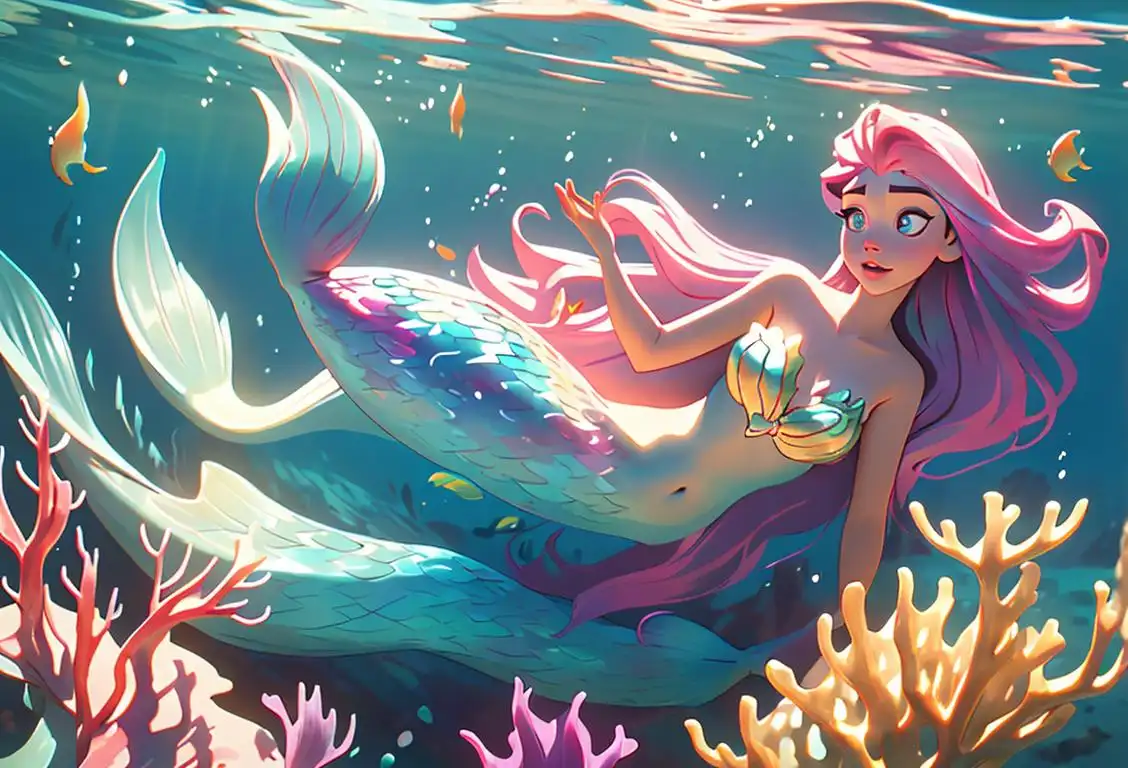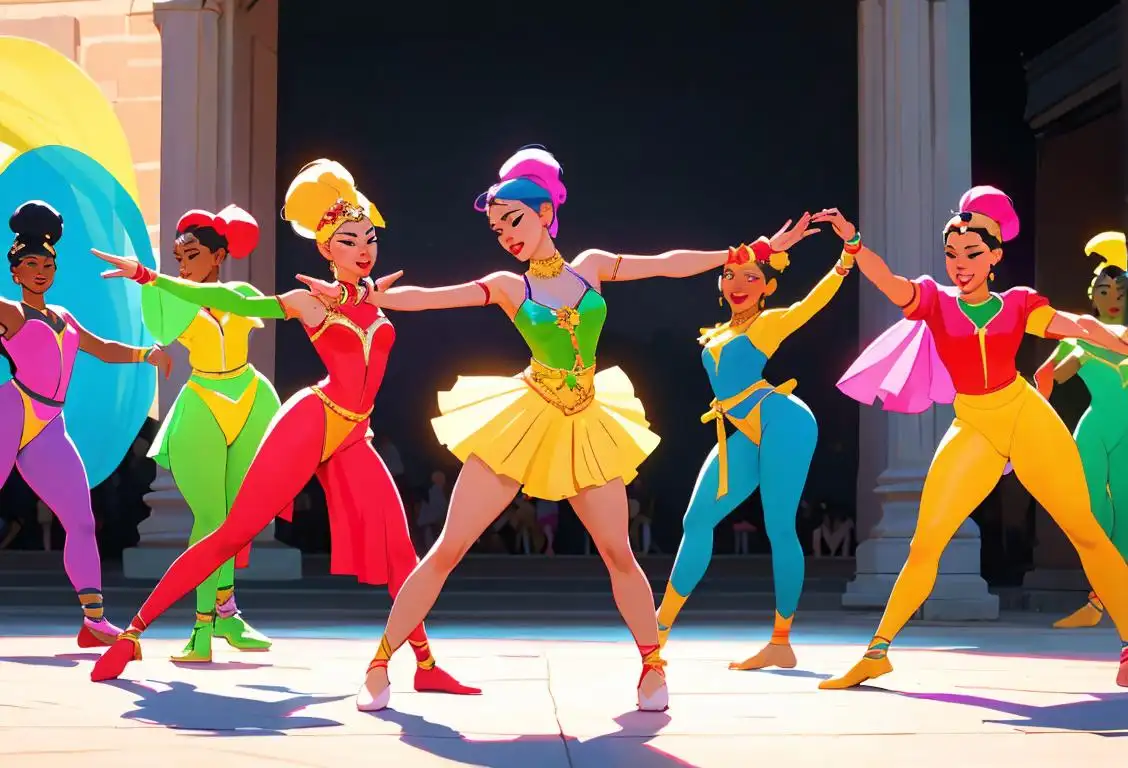National Mermaid Day

Whether it's Ariel from 'The Little Mermaid' or your childhood bathtub buddy, we all have a soft spot for mermaids. And that's why we celebrate National Mermaid Day with a splash of excitement! So grab your fish tail and dive into this enchanting celebration!
When is Mermaid Day?
It's national mermaid day on the 29th March.
A Tale as Old as Time
Mermaids have been mesmerizing humans for centuries with their half-fish, half-human allure. From ancient folklore to modern-day pop culture, mermaids have charmed their way into our hearts and imaginations.
The internet, being the magical realm that it is, couldn't resist dedicating a day to these mystical creatures. National Mermaid Day is a virtual celebration where mermaid enthusiasts unite to share their love and appreciation for these captivating beings.
Making Waves on the Internet
National Mermaid Day has made quite a splash online, with 125 mentions detected across the web. The most mermaid-themed buzz happened on March 29th, 2018, when mermaid fans went all out to mark this fin-tastic occasion.
Swimming in Fun Activities
To commemorate National Mermaid Day, enthusiastic merfolk and mermaid aficionados come together to organize various activities. People dress up in mermaid costumes, host online competitions for the best mermaid-inspired artwork, and even gather for fun-filled mermaid meetups!
For those who can't resist the call of the sea, there are mermaid-themed swimming classes where you can learn to glide through the water with graceful fin-like strokes. It's like living out your childhood dream of being a mythical sea creature!
Did You Know?
Did you know that mermaids have been a part of human folklore for over 3,000 years? Legends of half-human, half-fish beings can be traced back to ancient civilizations such as Mesopotamia and Assyria. These enchanting legends have enchanted people across cultures and continue to do so today!
History behind the term 'Mermaid'
1000 BC
Legendary Origins
The term 'mermaid' finds its roots in ancient folklore and mythology. In various cultures around the world, tales of half-human, half-fish creatures have been recounted since ancient times. The Assyrians, Greeks, and Romans all had their own versions of mermaid-like beings, often portrayed as seductive and enchanting creatures with the upper body of a human and the lower body of a fish.
1000s
First Appearances in Ancient Folklore
The term 'mermaid' originated in ancient folklore, with the earliest known mention of these mythical creatures dating back to the 1000s. Mermaids were often described as beautiful water spirits or half-human, half-fish beings who lived in the sea. They were said to possess enchanting voices and were sometimes depicted as creatures who lured sailors to their doom with their captivating songs and appearances.
1000 AD
First recorded mention of mermaids
The term 'mermaid' first appeared in the English language around the year 1000 AD. It was derived from the Old English word 'merewif,' which means 'sea woman' or 'water woman.' The concept of mermaids, however, predates this recording, as similar mythological creatures have been found in the folklore of many ancient civilizations, such as the Sirens in Greek mythology and water spirits in Nordic folklore.
1000 BC
The Ancient Origins
The term 'mermaid' finds its roots in the ancient civilizations of Babylon, Assyria, and ancient Greece. Many folklore and religious texts from this period mention creatures that resemble half-human, half-fish beings. These early depictions of mermaids were often associated with powerful deities and mythological creatures.
1000 BC
Ancient Mariners: Mermaid Legends Begin
Mermaid legends can be traced back to ancient times, with the earliest known references appearing in Assyrian mythology around 1000 BC. The goddess Atargatis was believed to transform into a mermaid out of shame for accidentally killing her human lover. These early myths established the foundation for future tales of mermaids.
1000 BCE
Ancient Sea Creatures
In ancient Assyrian and Babylonian mythology, there were stories of creatures called 'Apkallu' that were half-human and half-fish. These mythical beings were often depicted as wise and benevolent, serving as advisors to gods and kings. They laid the groundwork for the concept of mermaids.
1493
Mermaids in the Age of Discovery
During the Age of Discovery in the late 15th century, European explorers encountered various marine creatures, including manatees and dugongs, which are sometimes mistaken for mermaids. Christopher Columbus himself reported seeing mermaids during his voyage to the Caribbean in 1493. It is believed that these mistaken sightings contributed to the enduring myth of the mermaid.
1000 AD
Medieval Mermaid Tales
During the Middle Ages, tales of mermaids became more prevalent in European folklore. These stories often portrayed mermaids as enchanting and seductive beings, capable of luring sailors to their demise. The popular belief in these mythical creatures led to the emergence of various mermaid-related superstitions among seafaring communities.
1000 AD
European Depictions
During the medieval period, the concept of mermaids began to take on a more prominent role in European folklore. Often associated with beautiful singing and enchanting sailors, mermaids became a common theme in various artworks, including illuminated manuscripts and tapestries. They were often depicted as positive and alluring creatures, tempting sailors with their songs and beauty.
1493
Christopher Columbus' mermaid encounter
In 1493, during his voyage to the Caribbean, Christopher Columbus claimed to have seen three mermaids near the coast of the Dominican Republic. However, it is widely believed that the creatures he actually encountered were manatees. Columbus may have been influenced by the popular mermaid folklore of the time, leading to his misidentification.
100 AD
Greek Water Spirits
In Greek mythology, the term 'siren' was used to describe seductive female creatures who lived in the sea and lured sailors to their doom with their enchanting voices. Although not explicitly half-fish, the sirens played a significant role in shaping the idea of mermaids.
1493
Christopher Columbus' Encounter
In 1493, during his first voyage to the Americas, Christopher Columbus reported seeing mermaids near the coast of the Dominican Republic. However, his descriptions of these creatures were not as enchanting as the mythical beings of folklore. Instead, he described them as 'not half as beautiful as they are painted' and believed them to be manatees or dugongs. Despite Columbus' misidentification, his accounts played a significant role in popularizing the term 'mermaid' among European explorers.
1836
Hans Christian Andersen's 'The Little Mermaid'
One of the most famous works featuring mermaids is the fairy tale 'The Little Mermaid' written by Danish author Hans Christian Andersen. It was first published in 1836 and tells the story of a young mermaid who is willing to give up her underwater life for a chance to be with a human prince. This tale has been adapted into various forms of media and has significantly contributed to the popularization of mermaids in modern culture.
1837
Hans Christian Andersen's 'The Little Mermaid'
One of the most famous depictions of mermaids came in 1837 with the publication of Hans Christian Andersen's fairy tale, 'The Little Mermaid.' Andersen's story introduced a captivating narrative of a mermaid who longed to become human and experience love, capturing the imagination of readers worldwide. The popularity of 'The Little Mermaid' further cemented the concept of mermaids as enchanting and tragic figures, leaving a lasting cultural impact that would resonate through the decades.
1493
The 'Little Mermaid' Book
Hans Christian Andersen's fairy tale 'The Little Mermaid' was published in 1837, but it drew inspiration from earlier folklore. The story popularized the image of a mermaid - a young, beautiful creature with a fish tail who longed to be human. This tale helped propel the mermaid into popular culture.
1492
Christopher Columbus Encounter
When Christopher Columbus set sail for his voyage to the Americas, he recorded in his journal a remarkable encounter with mermaids. However, what he actually saw were manatees, peaceful marine mammals that inhabit coastal areas. Columbus' mistake led to the perpetuation of the idea that mermaids were real creatures rather than mythical beings.
1836
The Little Mermaid by Hans Christian Andersen
In 1836, Danish author Hans Christian Andersen published his iconic fairy tale 'The Little Mermaid.' This story gained worldwide popularity and became a defining narrative associated with mermaids. Andersen's tale portrayed mermaids as complex and tragic figures, further fueling the imagination and fascination surrounding these mythical creatures.
17th Century
Tales of Sirens
In the 17th century, the term 'mermaid' became more closely associated with dangerous and seductive creatures known as sirens. Popularized by epic poems like Homer's 'The Odyssey,' sirens were depicted as enchanting creatures with the ability to lure sailors to their doom with their captivating voices. This darker portrayal of mermaids influenced their future cultural significance.
1989
Disney's 'The Little Mermaid' movie
Disney's animated film 'The Little Mermaid,' released in 1989, further popularized the image of mermaids. The movie became a massive success, introducing the enchanting character Ariel to a whole new generation. The film's catchy songs, captivating story, and breathtaking underwater scenery helped solidify the mermaid's image as a beloved and mystical creature in the minds of millions.
1836
Hans Christian Andersen's 'The Little Mermaid'
One of the most significant instances in the history of mermaids was the publication of Hans Christian Andersen's fairy tale 'The Little Mermaid' in 1836. The story introduced a sympathetic and tragic mermaid protagonist, bringing a new depth and complexity to the popular depiction of mermaids. This tale sparked further interest and fascination with mermaid folklore.
1913
Aquatic Ballet: The First Mermaid Film
The first known full-length film featuring a mermaid was released in 1913, titled 'The Mermaid.' Directed by Herbert Brenon, this silent film showcased a mermaid performing aquatic ballet and marked the beginning of mermaids' presence in cinema. The film's success contributed to the enduring allure of mermaid characters in movies.
1886
Symbol of Coney Island
In 1886, a statue known as 'The Mermaid' was unveiled at the entrance to the Sea Lion Park in Coney Island, New York. This iconic statue inspired the use of mermaid imagery in Coney Island's amusement parks, making mermaids synonymous with the vibrant and playful atmosphere of the area.
1904
Disney's 'The Little Mermaid'
Nearly a century after Andersen's tale, Disney released an animated musical film adaptation of 'The Little Mermaid' in 1989. The film's success brought the story to a global audience, leading to a renaissance of mermaid-themed media and merchandise. Disney's portrayal of the mermaid protagonist Ariel, with her iconic red hair and voice, further solidified the modern image of a mermaid as a beautiful and relatable character, firmly entrenched in popular culture.
1836
The Little Mermaid
Danish author Hans Christian Andersen wrote and published the beloved fairy tale 'The Little Mermaid.' This story popularized the image of a beautiful mermaid longing to become human and inspired numerous adaptations in literature, theater, and later on, film. 'The Little Mermaid' is one of Andersen's most famous and enduring works.
2021
Contemporary Popularity and Symbolism
In the present day, mermaids continue to captivate people's imaginations and inspire various forms of artistic expression. The term 'mermaid' has transcended its mythical roots and has become symbolic of a free-spirited, independent, and empowering feminine figure. Mermaid imagery is prominent in art, literature, films, and even as a fashion trend. The allure of mermaids persists in our collective consciousness, representing a timeless fascination with the mysteries of the sea and the dream of adventure beyond the waves.
1989
Disney's Influence
With the release of Disney's animated film 'The Little Mermaid,' the concept of mermaids reached an even wider audience. The film's success introduced new generations to the iconic character of Ariel, publicizing mermaids as enchanting and relatable figures in popular culture. The enduring popularity of Disney's adaptation has helped solidify mermaids' place in modern folklore.
1989
Disney's 'The Little Mermaid'
Disney's animated film 'The Little Mermaid,' released in 1989, brought the mermaid into the mainstream of popular culture. The film's success reintroduced the enchanting mermaid concept, capturing the hearts of millions worldwide and solidifying the mermaid as a beloved mythical creature.
1989
Disney's The Little Mermaid Revives Popularity
Disney's animated feature film 'The Little Mermaid,' released in 1989, revitalized the worldwide interest in mermaids, reintroducing them to a new generation. The film's protagonist, Ariel, gained immense popularity and became an iconic symbol of mermaids. The success of 'The Little Mermaid' led to the creation of numerous mermaid-themed merchandise, further solidifying their presence in popular culture.
20th Century
Pop Culture Phenomenon
In the 20th century, mermaids became a widespread pop culture phenomenon. They appeared in movies like 'Splash' (1984) and 'The Little Mermaid' (1989) animated film, capturing the imagination of audiences worldwide. Mermaids also made their way into literature, fashion, and art, becoming iconic and often symbolizing themes of freedom, femininity, and the allure of the unknown.
Present
Continuing fascination with mermaids
In the present day, mermaids continue to captivate the imagination of people worldwide. Mermaid-themed attractions, such as mermaid shows and mermaid schools, have gained popularity. Mermaid cosplay has also become a notable subculture, with enthusiasts donning elaborate mermaid tails and participating in underwater performances. The enduring fascination with mermaids is a testament to their enduring appeal and the allure of the mythical world beneath the waves.
2020
Mermaid-Inspired Fitness and Fashion Trends
In recent years, mermaid-inspired fitness and fashion trends have gained popularity. Mermaid fitness classes, which involve swimming with a mermaid tail, have become a unique way to combine exercise and creativity. Additionally, mermaid-themed clothing, accessories, and makeup have become trendy fashion choices. This fusion of fantasy and reality continues to captivate people's imaginations, keeping the mermaid myth alive and thriving in modern culture.
Did you know?
Did you know that mermaids have been a part of human folklore for over 3,000 years?Tagged
romance funFirst identified
7th September 2015Most mentioned on
29th March 2018Total mentions
125Other days
Tv On The Same Day
Do Something Nice Day
Honesty Day
Iloveyou Day
Kiss A Ginger Day
Happiness Day
Dance Day
Compliment Day
Single Ppl Day
Suicide Prevention Month Day









